MARIANI’S
Virtual
Gourmet
November
19, 2017
NEWSLETTER

HAPPY
THANKSGIVING!
IN THIS ISSUE
WHAT'S DOING IN DC?
Part One
By John Mariani
NEW YORK CORNER
COSME
By John Mariani
NOTES FROM THE WINE CELLAR
TWO FINE WINE TASTINGS
By Geoff Kalish
❖❖❖
WHAT'S DOING IN DC?
Part One
By John Mariani
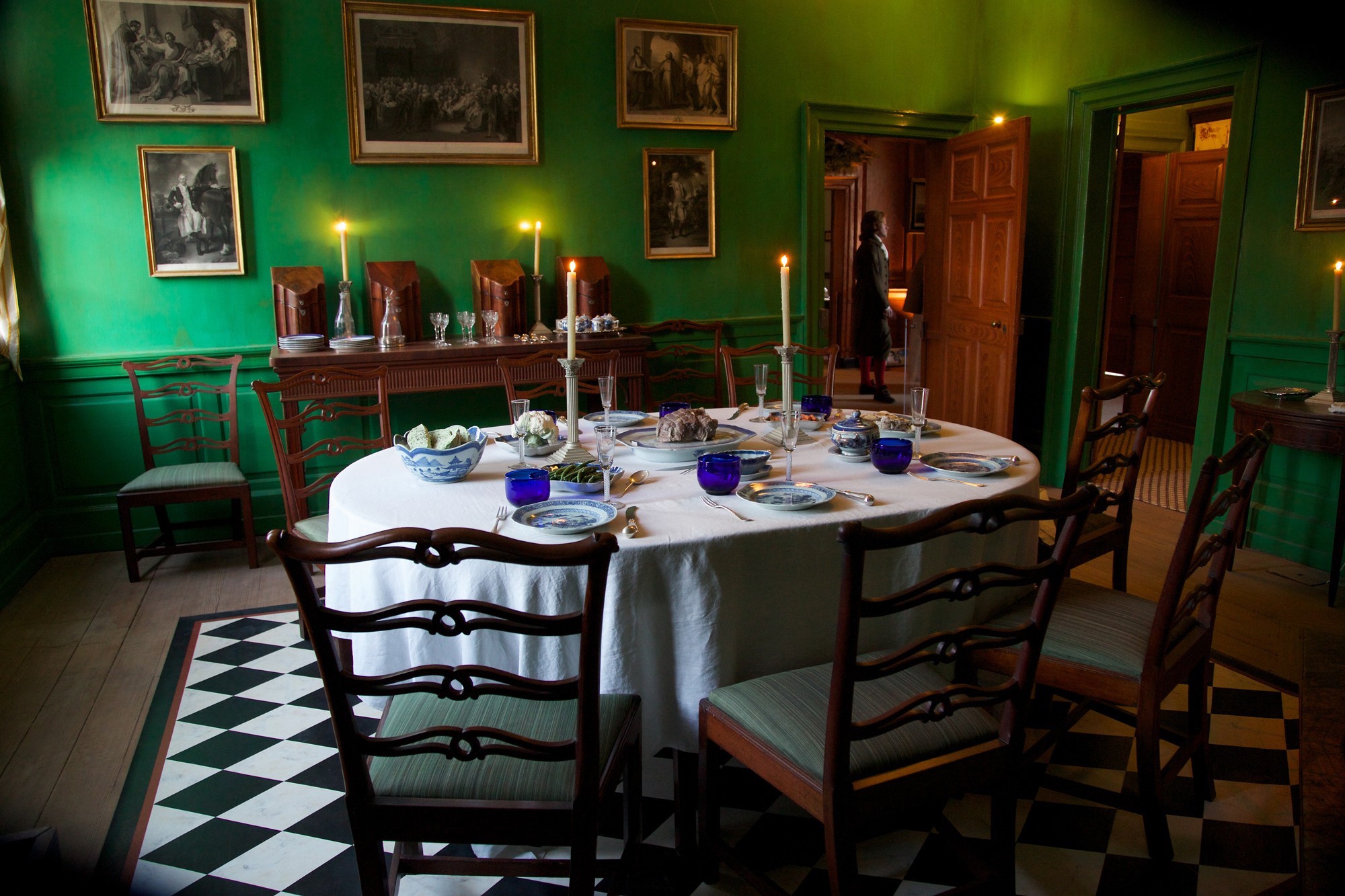
George and Martha Washington's Dining Room at Mount Vernon
Funny how Washington’s restaurant scene
is just now being recognized by the food media,
including the Michelin Guides, as one of
America’s finest food towns. It long has been,
dating back to the Reagan Era and the “power
lunch,” when
places like Le Pavillon, Jean-Louis at
The Watergate, Le Lion d’Or, The Jockey Club,
Cantina d’Italia and Duke Ziebert’s were packed
with pols and the lobbyists who seduced them.
By the 1990s D.C. was competitive with any city its size in the U.S., with innovative restaurants like Vidalia, Red Sage, Goldoni Galileo, DC Coast and I Ricchi (see below) opening regularly. So I’ve made annual visits to the Capital to check out what’s new, re-configured and still as good as ever. Here’s this year’s report.
KINGBIRD
The Watergate Hotel
2650 Virginia Avenue NW
202-827-1600
 It had been a very long
time—1986 to be exact—since I’d stepped foot
into The Watergate Hotel, which at that time
was home to the illustrious Jean-Louis
restaurant headed, until 1996, by the late
master chef Jean-Louis Palladin. For all
those years since, the hotel never made much
of an effort to come even close to that level
of fine dining.
It had been a very long
time—1986 to be exact—since I’d stepped foot
into The Watergate Hotel, which at that time
was home to the illustrious Jean-Louis
restaurant headed, until 1996, by the late
master chef Jean-Louis Palladin. For all
those years since, the hotel never made much
of an effort to come even close to that level
of fine dining.
Fortunately, however, the new restaurant Kingbird, if not trying to serve haute cuisine, has, under Chef Michael Santoro, restored a good deal of luster to a property that has always had a troubled history going back to the Nixon days, when its very name became synonymous with political shenanigans, even to the point of pundits attaching “-Gate” to practically any scandal.
Even today the current management offers a tour of “The Room Where It Happened - Scandal Room 214,” containing items from the era. After several ownership changes, the hotel, now owned by Euro Capital Properties, has kept its original brutish, toothy exterior by Luigi Moretti, has had an amazing transformation inside by Ron Arad. Today it has a futuristic spaceship look—more Forbidden Planet than Space Odyssey or Star Wars—done in many shades of white and gray and using Slinky toy-like chrome spirals from floor to ceiling as leitmotifs, beginning at the gleaming reception desk.
 The very spacious
bedrooms benefit from the sweeping curvature of
the building overlooking the Potomac, and the
décor of the rooms mirrors a minimalist look
brightened by rich leather fabrics and
plum-colored carpets.
The very spacious
bedrooms benefit from the sweeping curvature of
the building overlooking the Potomac, and the
décor of the rooms mirrors a minimalist look
brightened by rich leather fabrics and
plum-colored carpets.
The restaurant, which serves breakfast, lunch and dinner, uses the same motifs, with those soaring columns and hanging metal beehive lighting, and whose colors mimic that of the local kingbird. There is a glam bar on the way to the main dining room.
Executive Chef Michael Santoro, who had experience
at the experimental restaurants The Fat Duck
outside London and Mugaritz in Spain, then as chef
de cuisine at the Blue Duck Tavern in D.C., is
crafting a menu that seems highly personalized,
with plenty that might be called sophisticated
comfort food and much else that is artfully
composed around the seasons.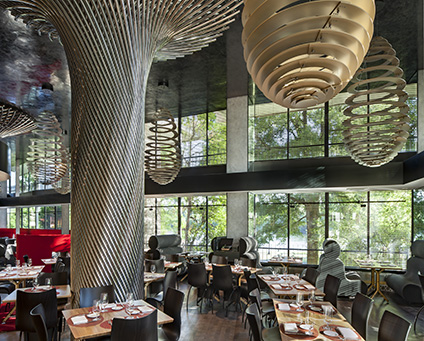
At my recent meal I began with a very good warm heirloom tomato with sheep’s milk ricotta, basil and candied olives ($16) and excellent Madai snapper crudo with a mosaic of avocado, radish and kalamansi ($20), whose textures were melded both sweetly and sensibly. Best of all was a warm summer tart of eggplant caponata and edible flowers ($13). That evening the seven-herb ravioli in an olive and capers sauce vierge and basil pesto ($15) had rather dry, chewy pasta dough and not much flavor.
For main courses, the Elysian Field saddle of lamb
was a fine piece of meat, served in a
Mediterranean style with smoked couscous, charred
eggplant and cucumber variations ($48), every
component complementary to boost flavors. 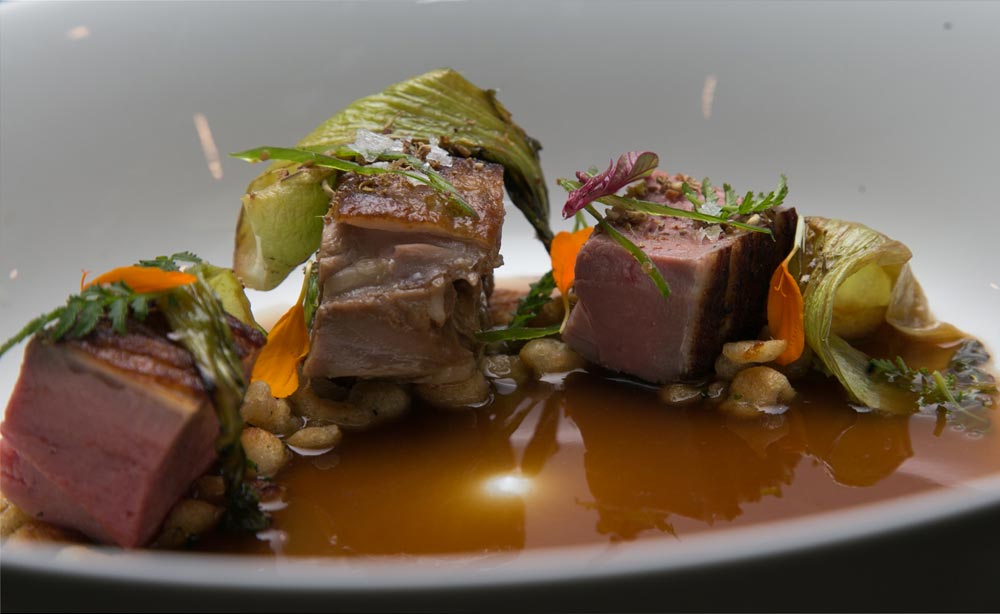
A bouillabaisse for two ($104) was
a lavish production but it didn’t achieve what a
simpler, ruddy and traditional bouillabaisse does
when the broth itself is deeply flavored by the
seafood.
Barbecued veal cheek was lusciously rendered, with grilled binchotan fresh beans, pickled sea beans and tomato ($34), while an eight-ounce beef tenderloin with cabbage, Shiraz wine and maître d’hotel butter ($48) had all the classic complexity it should.
For dessert there
was a bountiful serving of ripe, sweet peaches and
cream with vanilla ice cream and an enrichment of
brown butter.
The restaurant is very proud of its
stacked-up milkshakes, which are hefty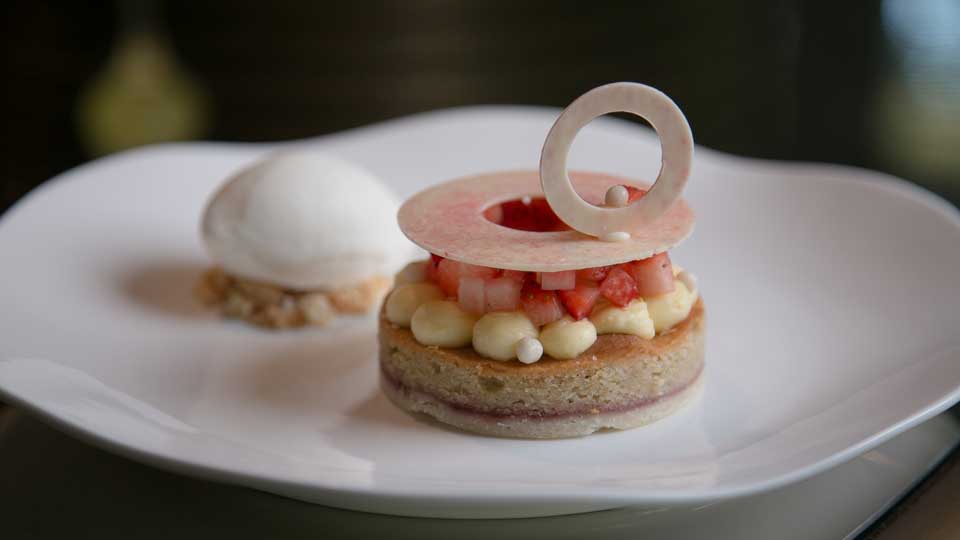 desserts but sheer fun.
desserts but sheer fun.
Kingbird stocks an impressive wine cellar, with a good selection of bottles under $50 but way too many wines above $150. A Peter Michael “Ma Belle-Fille” 2014 is about $100 retail, but $260 at Kingbird.
With its décor, its bar and its serious menu and wine list, Kingbird has more than shattered its lackluster image as a mere hotel dining room and restored it to The Watergate. Now, with its outdoor terrace, panorama on the river and the city, and its shiny new look, there are plenty of reasons to dine well here.
Just last week, the hotel introduced its Top of the Skate, a brand new rooftop skating rink at the Top of the Gate, rooftop bar, with a 360-degree view of the nation’s capital, as well as a special menu with seasonal offerings and treats such as Stromboli, S’mores, German-style hot pretzels and Mulled wine.
RISTORANTE I RICCHI
1220 19th Street NW
(202) 835-0459
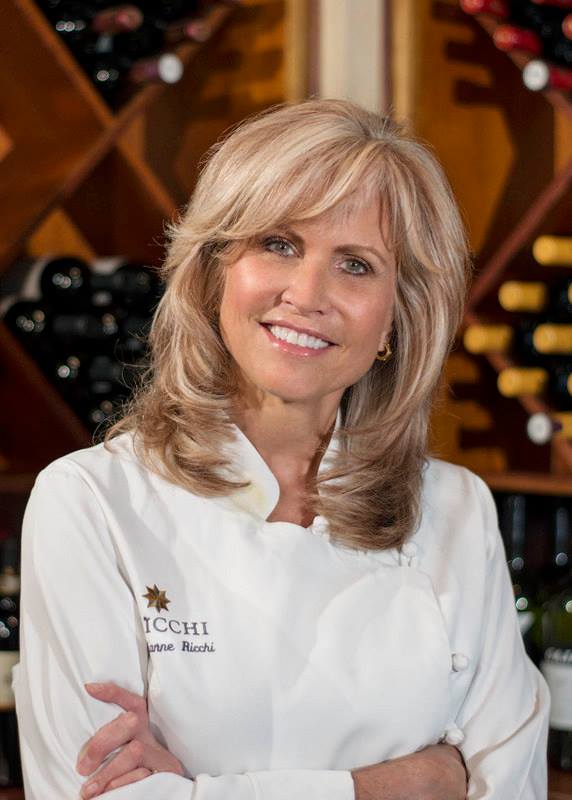 Now three decades in
business, I Ricchi in Dupont Circle has never
been better, and owner Christianne Ricchi will
probably never be satisfied tightening,
refining and tweaking the food and wine.
The beautiful, rustic Tuscan décor with its
terracotta floors and wood-burning hearth
looks as inviting as ever, and Ricchi herself
seems to know everyone at every table, as well
she should, for her regulars, who are legion,
are assured that no one in D.C. will take
better care of them. No one in the
business gets more of an earful of political
gossip than Ricchi. In addition, she’s been a
champion of women in the culinary world and
has the awards to prove it.
Now three decades in
business, I Ricchi in Dupont Circle has never
been better, and owner Christianne Ricchi will
probably never be satisfied tightening,
refining and tweaking the food and wine.
The beautiful, rustic Tuscan décor with its
terracotta floors and wood-burning hearth
looks as inviting as ever, and Ricchi herself
seems to know everyone at every table, as well
she should, for her regulars, who are legion,
are assured that no one in D.C. will take
better care of them. No one in the
business gets more of an earful of political
gossip than Ricchi. In addition, she’s been a
champion of women in the culinary world and
has the awards to prove it.
Twenty-eight years ago
Christianne opened the restaurant with her
husband, Francesco Ricchi, from whom she parted
ways after 17 years. He now owns Cesco in
Bethesda; she 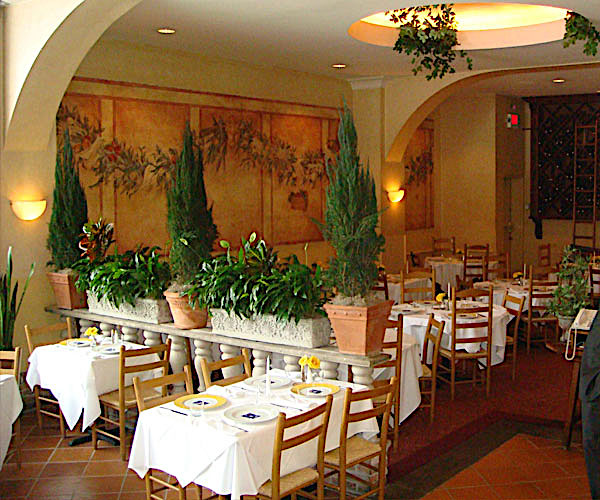 has full
ownership of I Ricchi.
has full
ownership of I Ricchi.
I had the good fortune to dine
and reminisce with Christianne a few weeks ago,
and we blew through a good portion of the menu,
both its classics and its seasonal dishes. Thus,
as antipasti
we had grilled Mediterranean octopus with
cucumber, tomato, arugula and balsamic vinegar
($18) and crisply fried, golden calamari with pomorola
tomato dipping sauce, lemon and fried parsley
($16)—a very tough dish not to polish off,
especially knowing what else was in the offing.
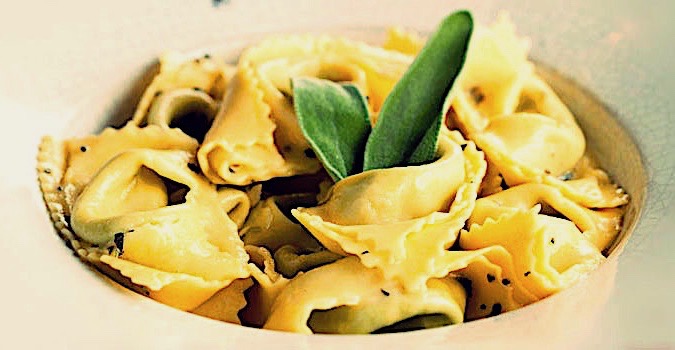 I sampled
three different pastas and a risotto, all
impeccably cooked, like the rigatoni with a
lustrous and deeply flavorful strasciate
meat sauce cooked for 12 hours ($20 as a main
course). Fat tortelloni
stuffed with ricotta and spinach needed nothing
more than a gloss of sage butter ($18), and the cavatelli shells
made
with squid ink, housemade fennel sausage, Gulf
shrimp and roasted tomato ($26) was one of those
rare pasta dishes involving squid ink—so often out
of a bottle—that had the true freshness and taste
of the sea in it. There is always a risotto of the
day (market price); that night, late in summer, it
was tenderly cooked with fresh corn, mascarpone
cheese and a dash of fresh thyme.
I sampled
three different pastas and a risotto, all
impeccably cooked, like the rigatoni with a
lustrous and deeply flavorful strasciate
meat sauce cooked for 12 hours ($20 as a main
course). Fat tortelloni
stuffed with ricotta and spinach needed nothing
more than a gloss of sage butter ($18), and the cavatelli shells
made
with squid ink, housemade fennel sausage, Gulf
shrimp and roasted tomato ($26) was one of those
rare pasta dishes involving squid ink—so often out
of a bottle—that had the true freshness and taste
of the sea in it. There is always a risotto of the
day (market price); that night, late in summer, it
was tenderly cooked with fresh corn, mascarpone
cheese and a dash of fresh thyme.
Largely, I Ricchi is a Tuscan ristorante
and grill, so the kitchen does very well by dishes
like orange marinated chicken with a rich balsamic
reduction and roasted rosemary speckled potatoes
($29). And
if you can’t decide among meat dishes, go for the
splendid mixed grill of marinated lamb chop,
prosciutto-stuffed baby quail, Tuscan sausage on
skewers and bay leaf scented crostini
($39).
I wish I could say
I just picked over dessert, but they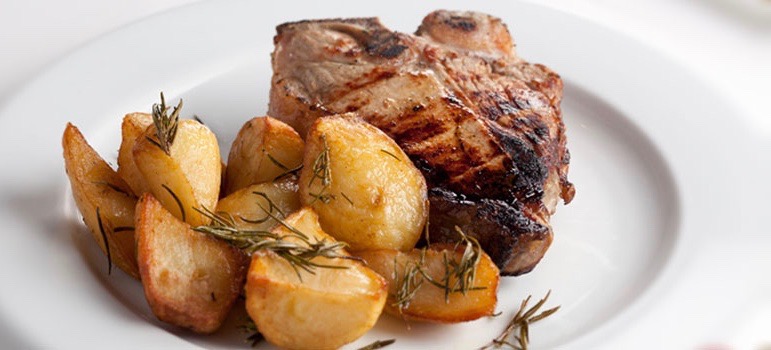 were too wonderful not to gorge
on—a chocolate meringue torta
with whipped cream and frozen chocolate mousse; a
walnut-crusted mascarpone cheese cake; and a semi-freddo
with strawberry cream and vanilla gelato (all $9).
were too wonderful not to gorge
on—a chocolate meringue torta
with whipped cream and frozen chocolate mousse; a
walnut-crusted mascarpone cheese cake; and a semi-freddo
with strawberry cream and vanilla gelato (all $9).
The wine list at I Ricchi is,
properly, wholly Italian, largely from small
wineries whose owners are well known to
Christianne.
Prices are not unreasonably hiked up.
I Ricchi is a celebratory
place, and Washington could use something to
celebrate these days. More important, it’s a place
anyone who loves Tuscan cuisine can go back to
again and again and expect the same care,
attention and quality every time. Having
Christianne Ricchi there to welcome you adds
immeasurably to the ambiance.
❖❖❖
By John Mariani
COSME
35 East 21st Street (near Park Avenue)
212-913-9659
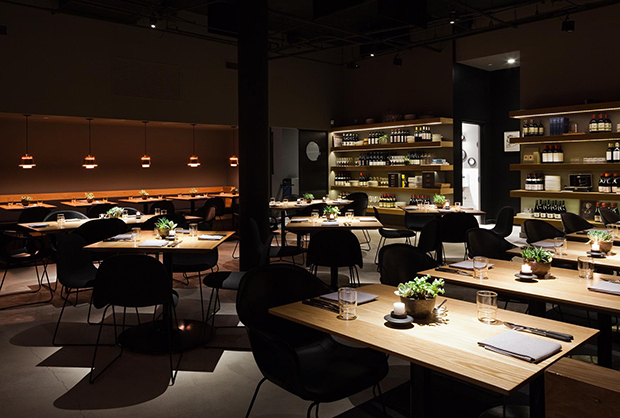 What can I say about
a restaurant with very good food that I’d never
want to go back to?
What can I say about
a restaurant with very good food that I’d never
want to go back to?
I suppose I begin with the
reason for the latter and end on the positive side
with the two-year old Cosme, a much-lauded Mexican
restaurant in the Flatiron District run by Chef
Enrique Olvera, who, with his many restaurantes
in Mexico—mostly notably Pujol—and abroad, is a
kind of South-of-the-Border Mario Batali. His
cuisine is a modern version of traditional Mexican
dishes, all done with flair and great
presentation.
Sadly, that presentation is within a dining
room so loud, raucous and music-driven that an
evening there is not the pleasure it should be.
As soon as I got through the
door, the decibels were bouncing off the ceiling
in the well-packed bar area. (My iPhone app
clocked it at the sound of a 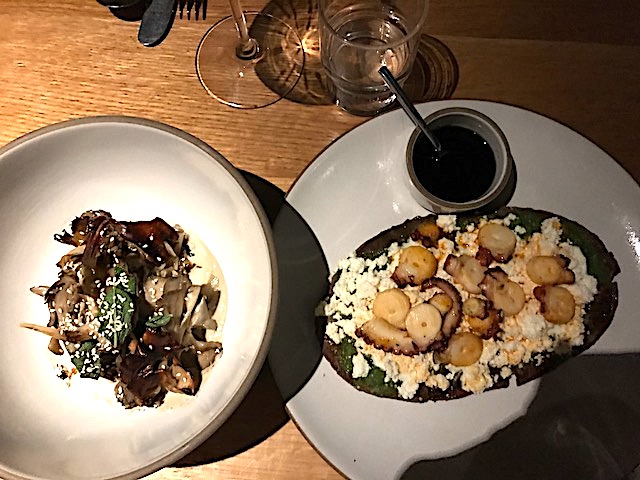 passing motorcycle.) I hoped
once I passed through that din the dining room
would be a far more civilized atmosphere, and it
was, but only by about ten percent. Actually it’s
a fairly handsome space, though very shadowy, as
if a lounge singer was about to appear to sing
“Besame Mucho.”
passing motorcycle.) I hoped
once I passed through that din the dining room
would be a far more civilized atmosphere, and it
was, but only by about ten percent. Actually it’s
a fairly handsome space, though very shadowy, as
if a lounge singer was about to appear to sing
“Besame Mucho.”
Black is not the most
convivial color for a ceiling. But the fact that
the décor is designed with no soft surfaces—bare
wooden tables, pillars, no buffering—makes it a
very noisy space, into which the management pipes
what sounded—were you even able to hear much
beyond the bass and drums—like disco or tech music
of no discernible style. Direct lighting on the
tables is, however, a very good way to show off
the beauty of the food.
So, with four other people, I
sat either yelling across the table to have
someone pass the wine (which was rarely poured by
any staff member) or in silence because
conversation with the person next to me was nearly
impossible.
I nodded my way through dinner, pretending
to hear what my tablemates were saying.
And that’s a damn shame,
because I truly liked the food at Cosme, which
comes out at a very fast pace but whose finished
plates don’t get removed in a timely way.
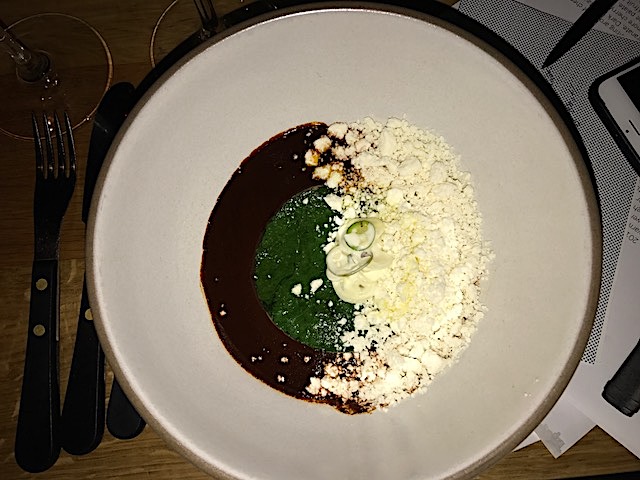 Dishes
may be shared, though portions are none too big.
The color and flair with which they are presented
is a delight, and the flavors are fascinating
amalgams of ideas both old and new. Thus we
began with a tostada with sea urchin, avocado,
cucumber and a salsa made with rich bone marrow
($21). Very
finely sliced scallops came with a carefully
modulated avocado aïoli and cool, sliced jicama
($23), while
enmoladas (enchiladas) were stuffed with
creamy ricotta, hojo santo,
and queso
fresco ($24).
Dishes
may be shared, though portions are none too big.
The color and flair with which they are presented
is a delight, and the flavors are fascinating
amalgams of ideas both old and new. Thus we
began with a tostada with sea urchin, avocado,
cucumber and a salsa made with rich bone marrow
($21). Very
finely sliced scallops came with a carefully
modulated avocado aïoli and cool, sliced jicama
($23), while
enmoladas (enchiladas) were stuffed with
creamy ricotta, hojo santo,
and queso
fresco ($24).
An order of lobster with shiso,
ginger, mojo,
and brown butter ($29) was less than halfway
cooked through, and a dish of hen of the woods
mushrooms with a less-than-complex white mole
and cabbage (left)
was very bland and certainly not worth $27. Chef de
cuisine Daniela Soto-Innes does a nice job with
octopus (above)
done as a memela—a
street snack made with a masa dough similar to a tostada—with
black beans, salsa verde
and queso
fresco ($28), meant to be shared.
A corn tempura-treated soft
shell crab with shishito mole
and tomatoes ($29) was a delicious turn with Asian
accents, but short rib with scallions, baby onions
and avocado ($36) was disappointing in its texture
and lack of deep flavors. Most
disappointing were  duck carnitas
with onions, radishes and cilantro (right), also
meant to be shared, but at $89, it should feed
four. Braised in Coca Cola and orange, its skin
becomes unpleasantly flaccid.
duck carnitas
with onions, radishes and cilantro (right), also
meant to be shared, but at $89, it should feed
four. Braised in Coca Cola and orange, its skin
becomes unpleasantly flaccid.
Desserts looked as good as the
appetizers and main courses, especially the husk
meringue with corn mousse ($16 is a lot for this)
and what is called “goat cheesecake” ($14) that
might better be termed “goat’s cheese cake.” The $14
yogurt shaved ice (raspado)
with palm seeds and chia
seeds was little more than sour.
The wine list is a good
selection, rich in Spanish bottlings, but prices
are sky high, with only a single red wine under
$50 and the majority over $100. There
are several signature cocktails (all $17), a slew
of tequilas and mezcals, and there are several
varieties of tea offered. It
would help if the menu explained the plethora of
Mexican food words.
I doubt
Cosme does take-out, though I wish they would. I’d
order more than half the dishes on the menu again. I just
wouldn’t consume them in that caterwauling dining
room.
❖❖❖
TWO WINE TASTINGS OF NOTE IN
NAPLES, FL
by Geoff Kalish
Grgich Hills Estate: 40 Years Young
 As
most wine aficionados know, Yugoslavia-born
Mijenko (“Mike”) Grgich migrated to California
via Germany and Canada in the early 1950s and
worked at Souverain, Christian Brothers,
Beaulieu and Mondavi before joining Chateau
Montelena as winemaker—where he produced a
Chardonnay that in 1976 bested a number of
French white Burgundies in the infamous
“Judgment of Paris” wine tasting. And in 1976,
along with coffee-heir Austin Hills, he founded
Grgich Hills Estate along Route 29 in Napa
Valley. Now, 94 years young, he’s still making
wine in both
California and Croatia, with the
day-to-day management of the California facility
passed on to his daughter, Violet, whose
mantra is “Everyday do something just a little
bit better.” Unfortunately, Mike’s winery in
Croatia suffered extensive damage in a fire and
is currently being rebuilt; he also witnessed
the recent fires that ravaged many of
California’s wine regions, but thankfully left
his winery unscathed.
As
most wine aficionados know, Yugoslavia-born
Mijenko (“Mike”) Grgich migrated to California
via Germany and Canada in the early 1950s and
worked at Souverain, Christian Brothers,
Beaulieu and Mondavi before joining Chateau
Montelena as winemaker—where he produced a
Chardonnay that in 1976 bested a number of
French white Burgundies in the infamous
“Judgment of Paris” wine tasting. And in 1976,
along with coffee-heir Austin Hills, he founded
Grgich Hills Estate along Route 29 in Napa
Valley. Now, 94 years young, he’s still making
wine in both
California and Croatia, with the
day-to-day management of the California facility
passed on to his daughter, Violet, whose
mantra is “Everyday do something just a little
bit better.” Unfortunately, Mike’s winery in
Croatia suffered extensive damage in a fire and
is currently being rebuilt; he also witnessed
the recent fires that ravaged many of
California’s wine regions, but thankfully left
his winery unscathed.
Recently, as part of
the 40-year anniversary of the founding of the
winery, a tasting of new releases was organized
by Jonathan Land, enthusiastic sommelier/manager
of The Wine Loft of Naples in Naples, Fla. It
featured the winery’s U.S. representative, Carl
Russo, discussing the wines and provided an
opportunity for The Wine Loft’s newly appointed
chef, Gilbert Loera, to show off some of his
talents in “small dishes” to pair with the
wines. Of importance: Under the direction of
Mike Grgich’s nephew, Ivo Jermaz, the winery’s
366 acres of vineyard are maintained
“naturally,” without artificial fertilizer,
pesticides or herbicides. 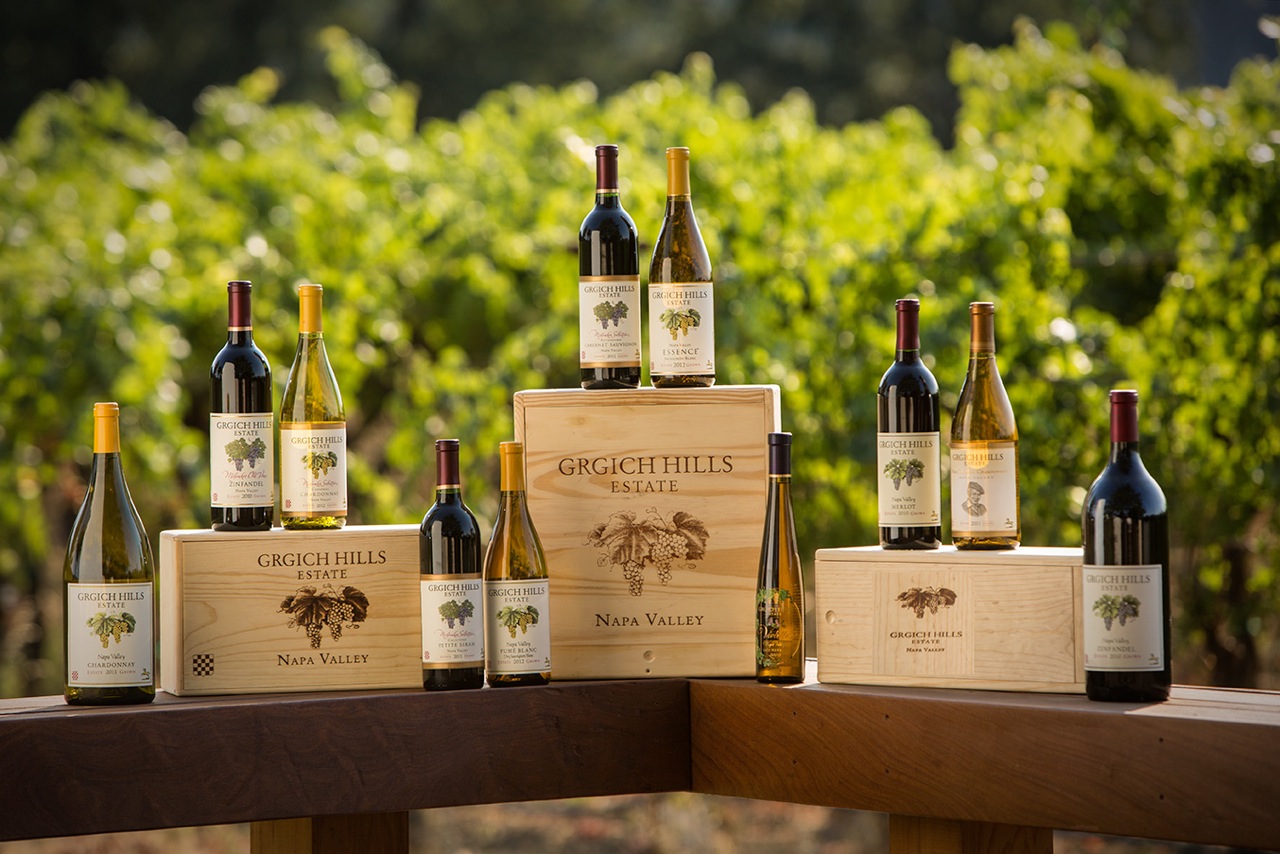 (On a sadder note,
Ivo’s house succumbed to the recent fires and he
and his family are currently residing in the
winery’s guest house.)
(On a sadder note,
Ivo’s house succumbed to the recent fires and he
and his family are currently residing in the
winery’s guest house.)
A first course of fig
and prosciutto crostini was accompanied by the
2014 Grgich Hills Fume Blanc ($31). Made from
Sauvignon Blanc grapes grown in the winery’s
American Canyon and Carneros vineyards (at the
southern tip of Napa Valley, near San Pablo
Bay), the wine showed a pale straw color,
bouquet of new mown hay and lemons with a taste
of lemongrass and notes of anise, with a
surprisingly long finish that married well with
the sweetness and crunchiness of the crostini.
Next
came the 2013 Grgich Hills Chardonnay ($43)
mated with dewy grilled salmon served over mixed
greens doused with a Dijon mustard and dill
dressing. This iconic100% Chardonnay, also
sourced from
vineyards in Carneros and American Canyon, is
barrel fermented with indigenous yeast, then
aged for 10 months in French oak (40% new).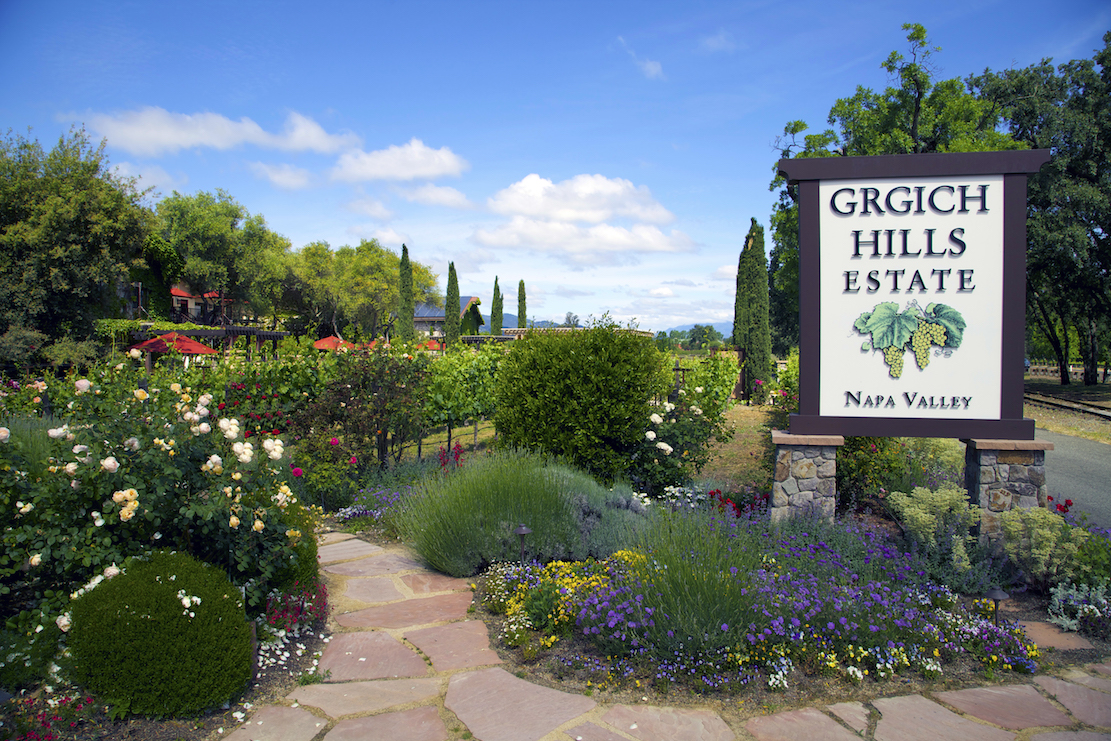 Very
Burgundian, it had a bouquet and taste of
apples, pears and even mangos with a long,
smooth finish, that brought out the salinity of
the salmon and yet was not overwhelmed by the
salad dressing. The 2013 Grgich Merlot ($43),
produced from 100% Merlot grapes and aged for 18
months in French oak barrels (30% new), showed a
bouquet and taste of ripe cherries and plums and
made perfect accompaniment to medium rare,
sliced filet-mignon, served with a berry
demi-glace, roasted cauliflower and garlicky
mashed potatoes—the wine accentuating the
natural sweetness of the beef and taming the
flavor of garlic. The 2014 Grgich Hills Cabernet
Sauvignon ($72), made of Cabernet Sauvignon
blended with small amounts of Merlot, Petit
Verdot and Cabernet Franc, had a bouquet and
taste of cassis and hints of cloves in its
finish, which gave a bit of zest to the lollipop
lamb chop served with a heady roasted root
vegetable medley.
Very
Burgundian, it had a bouquet and taste of
apples, pears and even mangos with a long,
smooth finish, that brought out the salinity of
the salmon and yet was not overwhelmed by the
salad dressing. The 2013 Grgich Merlot ($43),
produced from 100% Merlot grapes and aged for 18
months in French oak barrels (30% new), showed a
bouquet and taste of ripe cherries and plums and
made perfect accompaniment to medium rare,
sliced filet-mignon, served with a berry
demi-glace, roasted cauliflower and garlicky
mashed potatoes—the wine accentuating the
natural sweetness of the beef and taming the
flavor of garlic. The 2014 Grgich Hills Cabernet
Sauvignon ($72), made of Cabernet Sauvignon
blended with small amounts of Merlot, Petit
Verdot and Cabernet Franc, had a bouquet and
taste of cassis and hints of cloves in its
finish, which gave a bit of zest to the lollipop
lamb chop served with a heady roasted root
vegetable medley.
And the 2012 Grgich Zinfandel, blended with a very small amount of Petite Sirah and aged for 14 months in large French oak casks, had a bouquet and taste of black cherries and ripe plums. And, although I would have preferred it with the lamb, it mated quite well with a dessert consisting of a chocolate brownie topped with fresh blackberries—the Zinfandel enriching the flavor of the fruit. And for a finale, we were offered a taste of the 2013 Violetta Late Harvest ($85/375ml bottle), which had a honeyed taste of pears and apricots with a touch of acidity in its finish, a bit too sweet for the brownie, but would most likely mate well with fruit and/or ripe cheeses.
Rhone Ranger Shootout
Billed
whimsically as “A Game of Rhônes,” a recent
tasting of Rhône-style wines from California’s
Tablas Creek versus those of Maison Perrin of
France’s northern Rhône area (both wineries
partially owned and managed by Nicolas Perrin)
proved quite interesting. Held at The Naples
Wine Collection (an upscale retail store and
restaurant serving “small bites”), the event was
a walk-around tasting of three wines from each
producer, with representatives from the wineries
(Nicolas Jaboulet, co-owner of Maison Perrin,
and Darren Delmore, national sales manager of
Tablas Creek) available to answer questions. The
following are my notes on the event, which
should prove interesting, especially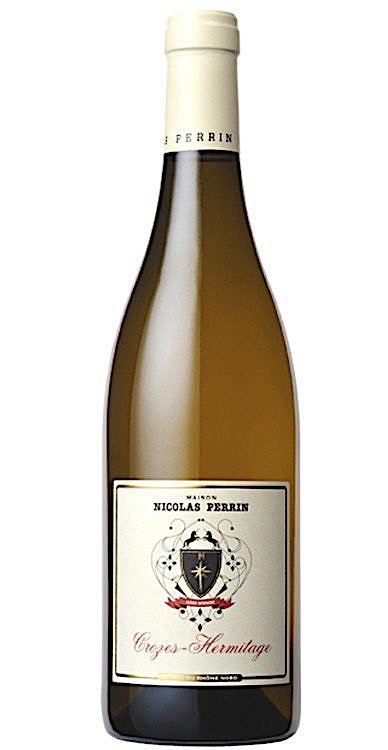 to the
growing number of consumers now gravitating to
wines from the Rhône area.
to the
growing number of consumers now gravitating to
wines from the Rhône area.
Although the 2014
Crozes Hermitage Blanc from Perrin ($19) was
made from 100% Marssanne grapes and the 2014
Tablas Creek Espirit de Beaucastel Blanc was a
blend of Roussanne (72%), Grenache Blanc (23%)
and Picpoul Blanc (5%), they showed similar
aesthetics, with a bouquet and flavor of apples,
pears and citrus, and should go quite well with
seafare, especially shrimp and prawns. However,
the Tablas Creek wine showed a depth and
richness bound to improve over a few years,
while the Perrin wine is unlikely to improve
much over time. Next up was a comparison of the
2014 Perrin Crozes Hermitage Rouge ($24) and the
Tablas Creek 2015 Côtes de Tablas Rouge ($37).
Even taking the slight difference in vintages
into account these were vastly different wines.
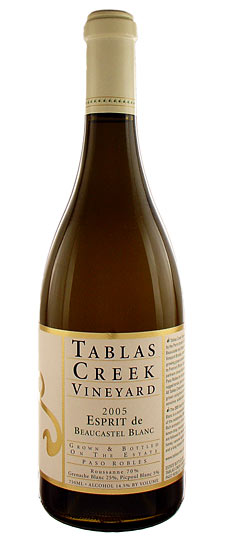 The
French wine made of 100% Syrah showed a vegetal
bouquet with a taste of strawberries and figs
and notes of mint in its finish that would mate
well with barbecued ribs and other grilled
meats. The Tablas Creek, made of a blend of 39%
Grenache, 35% Syrah, 16% Counoise and 10%
Mourvèdre, had a fragrant bouquet and rich taste
of ripe plums and blueberries with a long smooth
finish that would marry perfectly with game
birds, pasta with red sauce and even grilled
salmon. In
addition, it would be expected that, while both
wines will improve somewhat over the next few
years, the Tablas Creek would be drinking very
well in a decade, while the Perrin wine would be
“over the hill.”
The
French wine made of 100% Syrah showed a vegetal
bouquet with a taste of strawberries and figs
and notes of mint in its finish that would mate
well with barbecued ribs and other grilled
meats. The Tablas Creek, made of a blend of 39%
Grenache, 35% Syrah, 16% Counoise and 10%
Mourvèdre, had a fragrant bouquet and rich taste
of ripe plums and blueberries with a long smooth
finish that would marry perfectly with game
birds, pasta with red sauce and even grilled
salmon. In
addition, it would be expected that, while both
wines will improve somewhat over the next few
years, the Tablas Creek would be drinking very
well in a decade, while the Perrin wine would be
“over the hill.”
And,
finally, a comparison of the 2014 Tablas Creek
Espirit de Beaucastel Rouge ($63) and the Perrin
2013 Ermitage Rouge ($75): I
clearly preferred the Perrin wine, made from
100% Syrah and aged in a combination of new oak
(30%) and stainless steel, over the Tablas Creek
wine, a blend of Mourvèdre, Grenache, Syrah and
Counoise grapes. While both showed bouquets and
tastes of ripe cherries and raspberries, I found
the Perrin an extremely elegant wine with
multiple layers of flavor, even now in its youth
expected to be enjoyable with prime rib, lamb or grilled
tuna, while the Tablas Creek was an easy
drinking, but non-complex wine, more attuned to
the tastes of hamburgers and pizza.
❖❖❖
 ALSO, NEW
EVIDENCE SHOWS THAT WATER WILL NOT
ALSO, NEW
EVIDENCE SHOWS THAT WATER WILL NOT MAKE YOU FAT! OKAY, MAYBE A LITTLE BLOATED.
Based on advice by researcher Brian Wansink,
of Cornell U. :
• “Small plates help you eat less.”
• “People who display fruit on kitchen counters have
lower BMIs.”
• “Kids love vegetables when you
make them sound cool.”
AVOID CLICHÉS THAT SOUND

STOLEN FROM AN OLD EPISODE
OF "THE ANDY GRIFFITH SHOW."
Any of John Mariani's books below may be ordered from amazon.com.
 The
Hound in Heaven (21st Century Lion Books)
is a novella, and for anyone who loves dogs,
Christmas, romance, inspiration, even the supernatural, I
hope you'll find this to be a treasured favorite.
The story concerns how, after a New England teacher,
his wife and their two daughters adopt a stray puppy found
in their barn in northern Maine, their lives seem full of
promise. But when tragedy strikes, their wonderful dog
Lazarus and the spirit of Christmas are the only things
that may bring his master back from the edge of
despair.
The
Hound in Heaven (21st Century Lion Books)
is a novella, and for anyone who loves dogs,
Christmas, romance, inspiration, even the supernatural, I
hope you'll find this to be a treasured favorite.
The story concerns how, after a New England teacher,
his wife and their two daughters adopt a stray puppy found
in their barn in northern Maine, their lives seem full of
promise. But when tragedy strikes, their wonderful dog
Lazarus and the spirit of Christmas are the only things
that may bring his master back from the edge of
despair. WATCH THE VIDEO!
“What a huge surprise turn this story took! I was completely stunned! I truly enjoyed this book and its message.” – Actress Ali MacGraw
“He had me at Page One. The amount of heart, human insight, soul searching, and deft literary strength that John Mariani pours into this airtight novella is vertigo-inducing. Perhaps ‘wow’ would be the best comment.” – James Dalessandro, author of Bohemian Heart and 1906.
“John Mariani’s Hound in Heaven starts with a well-painted portrayal of an American family, along with the requisite dog. A surprise event flips the action of the novel and captures us for a voyage leading to a hopeful and heart-warming message. A page turning, one sitting read, it’s the perfect antidote for the winter and promotion of holiday celebration.” – Ann Pearlman, author of The Christmas Cookie Club and A Gift for my Sister.
“John Mariani’s concise, achingly beautiful novella pulls a literary rabbit out of a hat – a mash-up of the cosmic and the intimate, the tragic and the heart-warming – a Christmas tale for all ages, and all faiths. Read it to your children, read it to yourself… but read it. Early and often. Highly recommended.” – Jay Bonansinga, New York Times bestselling author of Pinkerton’s War, The Sinking of The Eastland, and The Walking Dead: The Road To Woodbury.
“Amazing things happen when you open your heart to an animal. The Hound in Heaven delivers a powerful story of healing that is forged in the spiritual relationship between a man and his best friend. The book brings a message of hope that can enrich our images of family, love, and loss.” – Dr. Barbara Royal, author of The Royal Treatment.
 |
The Encyclopedia of American Food and Drink by John F. Mariani (Bloomsbury USA, $35) Modesty forbids me to praise my own new book, but let me proudly say that it is an extensive revision of the 4th edition that appeared more than a decade ago, before locavores, molecular cuisine, modernist cuisine, the Food Network and so much more, now included. Word origins have been completely updated, as have per capita consumption and production stats. Most important, for the first time since publication in the 1980s, the book includes more than 100 biographies of Americans who have changed the way we cook, eat and drink -- from Fannie Farmer and Julia Child to Robert Mondavi and Thomas Keller. "This book is amazing! It has entries for everything from `abalone' to `zwieback,' plus more than 500 recipes for classic American dishes and drinks."--Devra First, The Boston Globe. "Much needed in any kitchen library."--Bon Appetit. |
"Eating Italian will never be the same after reading John Mariani's entertaining and savory gastronomical history of the cuisine of Italy and how it won over appetites worldwide. . . . This book is such a tasteful narrative that it will literally make you hungry for Italian food and arouse your appetite for gastronomical history."--Don Oldenburg, USA Today. "Italian
restaurants--some good, some glitzy--far
outnumber their French rivals. Many of
these establishments are zestfully described
in How Italian Food Conquered the World, an
entertaining and fact-filled chronicle by
food-and-wine correspondent John F.
Mariani."--Aram Bakshian Jr., Wall Street
Journal.
"Equal parts
history, sociology, gastronomy, and just
plain fun, How Italian Food Conquered the
World tells the captivating and delicious
story of the (let's face it) everybody's
favorite cuisine with clarity, verve and
more than one surprise."--Colman Andrews,
editorial director of The Daily
Meal.com. "A fantastic and fascinating
read, covering everything from the influence
of Venice's spice trade to the impact of
Italian immigrants in America and the
evolution of alta cucina. This book will
serve as a terrific resource to anyone
interested in the real story of Italian
food."--Mary Ann Esposito, host of PBS-TV's
Ciao
Italia. "John Mariani has written the
definitive history of how Italians won their
way into our hearts, minds, and
stomachs. It's a story of pleasure over
pomp and taste over technique."--Danny Meyer,
owner of NYC restaurants Union Square
Cafe, The Modern, and Maialino.
|
 |
 |
 |
 |
 |
 |
 |
 |
 Everett Potter's Travel Report:
Everett Potter's Travel Report: 
 Eating Las Vegas
JOHN CURTAS has been covering the Las Vegas
food and restaurant scene since 1995. He is
the co-author of EATING LAS VEGAS – The 50
Essential Restaurants (as well as
the author of the Eating Las Vegas web site: www.eatinglasvegas.
He can also be seen every Friday morning as
the “resident foodie” for Wake Up With the
Wagners on KSNV TV (NBC) Channel 3 in
Las Vegas.
Eating Las Vegas
JOHN CURTAS has been covering the Las Vegas
food and restaurant scene since 1995. He is
the co-author of EATING LAS VEGAS – The 50
Essential Restaurants (as well as
the author of the Eating Las Vegas web site: www.eatinglasvegas.
He can also be seen every Friday morning as
the “resident foodie” for Wake Up With the
Wagners on KSNV TV (NBC) Channel 3 in
Las Vegas.

MARIANI'S VIRTUAL GOURMET
NEWSLETTER is published weekly. Editor/Publisher: John
Mariani.
Editor: Walter Bagley. Contributing Writers: Christopher Mariani,
Robert Mariani, Misha Mariani, John A. Curtas, Geoff Kalish, Mort
Hochstein, and
Brian Freedman. Contributing Photographer: Galina
Dargery. Technical Advisor: Gerry McLoughlin.
To un-subscribe from this newsletter,click here.
© copyright John Mariani 2017

